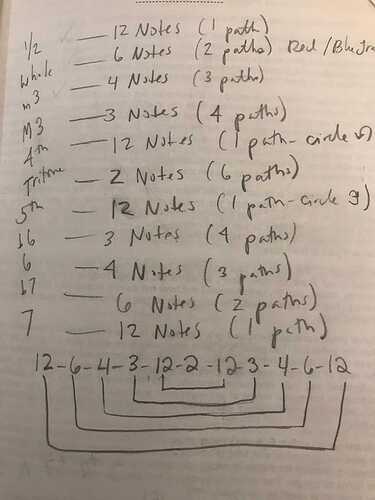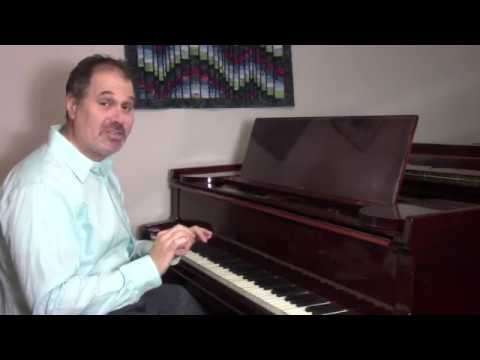I created this visual when doing the Landscape activity on the piano, sharing in case others find it helpful. I’m working on diminished chords now and it’s cool to see that they are just the Landscape with minor 3rds (and there are just 3 of them really).
hoihoi
can you please explain what you mean by ’ path’.
a path , 1 x octaaf?
inclusive all notes?
thanks.
Vny:-)
Hi Vinny! Sorry that was not clear, and I didn’t explain. In the first row, when you are exploring half steps, you have the entire keyboard available, or one path.
In the second row, with whole steps, no matter which note you start on, if you only play whole steps, you will have exactly half of the keyboard available. But if you start with a note half step above your original starting note, then you will have the other half of the keyboard available. So if you are only playing whole steps, there are two different “paths” available. In other words, one path is C, D, E, F#, G#, A#, C all over the keyboard. The other is C#, D#, F,G,A,B,C# all over the keyboard.
Then as you explore minor thirds, you will find that there are three different “paths” depending on which note you start on. (Minor thirds stacked together create a diminished chord and in fact there are also only three diminished chords.) And so on.
If this is still unclear let me know and I can make a video.
Best,
Angela
Angela
thanks for your explaning 
vny:-)
Thanks… very useful to me. Pass on any other piano finds when you can.
Hi Angela - here’s #1 of a 3 part series on Youtube (very short videos) that suggest IFR-like exercises on the piano as the first step in improvising, with a big emphasis on FLOW to begin with. You might like these for an investment of 10 minutes or so… and you can easily see how to expand them after you get going. Very hypnotic to do.
@hender99 Thanks for that. 10 minutes well spent. Nice attitude.  I downloaded his ebook too (there’s a link on the youtube page).
I downloaded his ebook too (there’s a link on the youtube page).
This is great Angela.
I am right at the beginning and have a few questions that you may be able to help with.
Are we supposed to use both hands at this stage?
If the 5 semitone exercise supposed to stay in one octave?
Should we be aiming to preempt ( sing) the tones we are choosing.
Thanks for your previous post.
Floyd
Hi!
I would use just one hand at first to really focus on the interval sounds.
Start small and then expand out to a bigger range (outside an octave).
I think you could try to sing first if you know the tones, or listen and sing back if you don’t. Whatever helps you really internalize the landscape. Just my ideas, I’m a student too so others might have additional advice.
Hi @Angela, thank you for this wonderful contribution! This is exactly what I was trying to describe in a short video I published called “Becoming a Music Philosopher”. What I meant was to encourage people to decide their own interests, ask their own questions, and seek their own answers. Your musings on the number of paths generated by the different intervals are (in my humble opinion) the highest form of music theory because you’re asking your own original questions and you’re investigating the harmonic landscape yourself to determine the answers. Not only does this lead to new insights and understanding, but it also leads to a deeper personal love affair with harmony because of this intimate experience of exploring it yourself. It’s just a perfect example of how music theory can be beautiful when it’s an expression of our own curiosity and our intellectual freedom to think and explore for ourselves.
Thanks also for your perfect answer to @dafloydman. I couldn’t have said it better myself!
David
David,
It wasn’t until I found IFR that I really found my musical voice. I have spent countless dollars on countless programs, but only IFR has brought me towards my goal of being able to create music. In the past I have shared with you my discoveries and progress, and you’ve always responded as you just did to both Angela and Floyd. You are truly excited at the progress of others, and you are nothing but encouraging. You always respond with thoughtful comments that not only encourage, but also validate and spur us on towards more musical self expression.
I have met several people on this forum who find ways to teach themselves, and expand on the ideas into which you have poured your soul, and when they do, you always show pure enthusiasm for their discoveries and inventions. Kudos to you, David, and to Angela and Floyd and DavidW!
This is the musical community I’ve been searching for.
Woody
@woodyhaiken, thank you so much for your kind words. Believe me, we were searching for you as much as you were searching for us!  IFR is a very special community of people who see music as a place of beauty, discovery and self-expression. You can see from this forum that we all have many different perspectives and interests. But what I most admire about this community is the spirit of love, encouragement and humility. This is partly because of the way we present IFR as a place where everyone’s musical voice is equally beautiful and important, a notion which makes more authoritarian or ego-driven musicians blow a gasket and run for the hills. But we’ve also been lucky that a few special musicians have been especially present and constant in this forum, which allows new people like yourself to see what we’re all about. I’m so happy you’ve joined the group! I hope that the group continues to serve you, and I really appreciate your comments.
IFR is a very special community of people who see music as a place of beauty, discovery and self-expression. You can see from this forum that we all have many different perspectives and interests. But what I most admire about this community is the spirit of love, encouragement and humility. This is partly because of the way we present IFR as a place where everyone’s musical voice is equally beautiful and important, a notion which makes more authoritarian or ego-driven musicians blow a gasket and run for the hills. But we’ve also been lucky that a few special musicians have been especially present and constant in this forum, which allows new people like yourself to see what we’re all about. I’m so happy you’ve joined the group! I hope that the group continues to serve you, and I really appreciate your comments.
And thanks @DavidW for posting the link to the video I referenced. I forgot that I could do that. Everyone’s talking about Web 3.0 and I’m still trying to figure out Web 1.0. 
Great to hear that IFR has unlocked a door for you. It did for me as well.


